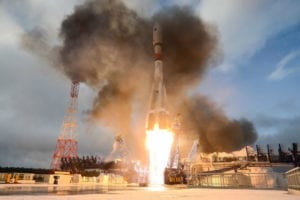
By Roger McDermott
This essay was originally published by the Eurasia Daily Monitor of The Jamestown Foundation on 8 April 2020, and is republished here with their kind permission. The original essay can be found here.
In December 2019, President Donald Trump formally created the United States Space Force, a development that Moscow has been following with keen interest. As the US takes additional steps to develop this newest military branch, the Russian military continues to further strengthen its own space-based assets—particularly those related to expanding orbital electronic warfare (EW) capabilities, boosting communications systems, and developing space infrastructure for attacking the ground-based targets of hypothetical adversaries (Rossaprimavera.ru, April 3). Moreover, Moscow is tying these efforts to enhancing its strategic air defense, especially against an enemy air-and-space campaign involving unmanned aerial vehicles (UAV), cruise missiles and hypersonic missiles combined with air force platforms. These efforts to advance the power and reach of Russia’s military in future operations will be closely linked to its exploitation of outer space and its ongoing efforts to catch up with other actors or to offset its comparative weaknesses in this domain (Gazeta.ru, April 3).
Russia’s political-military leadership frequently expresses concern about the potential “militarization of space.” On February 25, Russian Foreign Minister Sergei Lavrov, speaking at a disarmament conference in Geneva, said that the North Atlantic Treaty Organization (NATO) plans to launch weapons into space and that mutually-acceptable measures must be worked out among all parties to prevent a military confrontation in near-Earth space. “The plans of the United States, France and the North Atlantic Alliance as a whole to launch weapons into space are gaining more and more real shape. We are convinced that it is not too late to work out universally acceptable measures that can prevent a military confrontation in outer space,” Russia’s top diplomat claimed (Nezavisimoye Voyennoye Obozreniye, March 15).
According to experts, there are currently 2,200 satellites in near-Earth orbit, with approximately 1,000 belonging to US companies, governmental or scientific institutions, including 189 for military purposes. Russia has around 160 satellites in space, with around 100 serving military functions. Among these are 51 space communications vehicles and 16 opto-electronic reconnaissance satellites. Moscow is prioritizing keeping these in working condition and making additional efforts to further boost its space-based systems to strengthen its military power (Gazeta.ru, April 3).
The financial data provided by the state corporation Roscosmos suggests that Moscow spends around $1 billion annually to develop its military orbital grouping, launch vehicles and launches. Spending on the GLONASS space navigation system (27 satellites) in 2019 amounted to $437 million; and expenditure on the Plesetsk military space center total $100 million annually. When staff salaries and the servicing of ground-based infrastructure is factored into the overall costs, Moscow’s military space program budget likely reaches around $1.6 billion (Gazeta.ru, April 3).
One key area for priority development is Moscow’s use of space to increase its EW capabilities. This is rooted in the belief the wars of the future will witness a concerted effort to deny effective communications to enemy forces by targeting space-based assets. Russian media has reported on the US Space Force receiving the new Counter Communications System (CCS) Block 10.2 strike complex, designed to attack in-orbit communications systems. The task of such complexes is not to bring down enemy satellites but to jam their signals. Reportedly the Block 10-2 strike complex deployed at the Peterson Airbase, in Colorado, is capable of jamming various radio communications and satellite signals coming from an altitude of 36,000 kilometers and above; in theory, this could interfere with enemy early-warning systems for observing missile attacks. The Block 10.2 is an upgraded version of a US jammer first deployed in 2004. However, Moscow also uses these types of assets, with its Tirada-2S entering service in 2018 and work is currently in progress to develop new-generation jammers to serve as anti-satellite strike complexes (Utro.ru, March 19).
Russia’s military space program forms a key component in its efforts to improve its intelligence, surveillance and reconnaissance (ISR) capabilities to increase the accuracy and targeting of fires and conventional precision-strike. Recent military exercises, including Tsentr 2019, have rehearsed the capabilities of its air-defense assets to withstand an adversary air and space attack using a mix of bombers, strike complexes, UAVs and cruise and hypersonic missiles. These scenarios represent an increasing feature of Russian military exercises and are heavily tied to the ongoing development of Russia’s space-based capabilities (Izvestia, April 6, 2020; see EDM, October 15, 2019).
Moscow’s efforts to boost its space-based military assets may be mitigated by corruption. In 2018, cases of abuse and fraud in this sector reached $1 billion. And the following year, 58 people were sentenced to various terms of imprisonment after $172 million was stolen from the Vostochny Cosmodrome, in the Russian Far East. By November 2019, only part of the lost money had been recovered. When asked about corruption in Roskosmos, the head of the Investigative Committee of Russia, Alexander Bastrykin, said that “there is no end in sight.” Another issue relates to the service life of Russian satellites, currently around 50 percent of their US counterparts. Thanks to access to the European and US electronic component base in previous years (until 2014), Moscow could extend the life of some of its military satellites. But the rotation speed of the Russian orbital grouping began to decrease since 2010. Without access to Western technologies and a modern electronic-component base, it will remain difficult for Moscow to create its military spacecraft and maintain its orbital constellation at the required level in the coming years (Gazeta.ru, April 3).
Moscow’s military exploitation of space is rooted in its wider drive to exponentially strengthen Russian ISR capabilities in support of targeting of fires. It also seeks to further develop EW capability in areas such as jamming enemy satellites and communications. Its overall space-based efforts, on the other hand, may well be inhibited by access to technologies relying on Western components as well as the success of stemming the internal flow of corruption in the defense and space industries.
Roger N. McDermott specializes in Russian and Central Asian defense and security issues and is a Senior Fellow in Eurasian Military Studies, The Jamestown Foundation, Washington DC, Senior International Research Fellow for the Foreign Military Studies Office (FMSO), Fort Leavenworth, Kansas, and Affiliated Senior Analyst, Danish Institute for International Studies, Copenhagen. McDermott is on the editorial board of Central Asia and the Caucasus and the scientific board of the Journal of Power Institutions in Post-Soviet Societies. He recently wrote The Reform of Russia’s Conventional Armed Forces: Problems, Challenges and Policy Implications (October 2011).
 SpaceWatch.Global An independent perspective on space
SpaceWatch.Global An independent perspective on space





